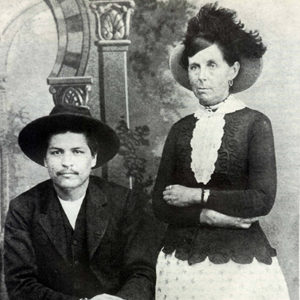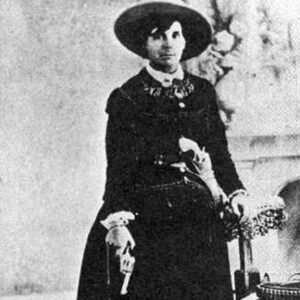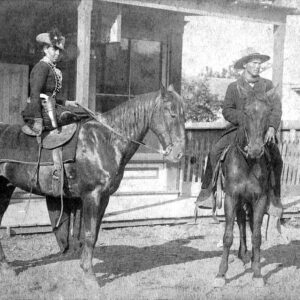calsfoundation@cals.org
Belle Starr (1848–1889)
aka: Myra Maybelle Shirley
In the late 1800s, Belle Starr was known as a notorious female outlaw in America’s “Old West.” As a resident of Indian Territory, now Oklahoma, she came under the jurisdiction of Judge Isaac C. Parker in Fort Smith (Sebastian County). Her close friends included the legendary American outlaws Cole Younger and Frank and Jesse James. Her reputation as an outlaw, the novelty of being a woman outlaw, and her violent, mysterious death led to her being called “The Bandit Queen.”
Belle Starr was born Myra Maybelle Shirley near Carthage, Missouri, on February 5, 1848. Her father was John R. Shirley, a farmer who later owned a local inn. Her mother, twenty years younger than her husband, was Elizabeth (Eliza) Hatfield Shirley, who was related to the Hatfield family of the infamous Hatfield-McCoy feud. As a child, Shirley attended Carthage Female Academy. She enjoyed the outdoors and horseback riding, becoming a better rider than most women of her time. Among Shirley’s childhood friends in Missouri was Cole Younger, who after the Civil War joined neighbors Frank and Jesse James in robbing trains, stagecoaches, and banks. Fleeing the law, they sometimes hid on the Shirley farm, and the teenage Shirley became influenced by their life of crime.
In 1866, she married another childhood acquaintance, James C. Reed, the son of Solomon Reed, a prosperous local farmer. James and Myra Reed had two children, daughter Rosie Lee, called “Pearl,” and son James Edwin, called “Eddie.” After trying unsuccessfully to become a farmer, her husband joined with the Starr clan, an outlaw Cherokee family in Indian Territory who stole horses, rustled cattle, and bootlegged whiskey. James Reed was accused of robbery in 1874, and Myra Reed was accused of being an accomplice. They fled to Texas, and in 1874, he was killed while trying to escape the authorities.
After his death, Myra Reed joined the Starr clan and lived in Indian Territory west of Fort Smith. She married one of them, Samuel Starr, in 1880, at which point she began calling herself “Belle.” She was said to act as a front for bootleggers and to harbor fugitives. With Fort Smith having the nearest court of law, she came to the attention of Judge Isaac Parker, who was known as the “Hanging Judge” for his severe sentences. On November 9, 1882, she and Sam Starr were charged in the U.S. Commissioner’s Court at Fort Smith with the larceny of two horses. On March 8, 1883, a jury returned a guilty verdict, and Judge Parker sentenced the Starrs to a year in prison. It was a surprisingly lenient sentence; Judge Parker was said to have taken into consideration the fact that it was the first conviction for both, and he expressed hope that they would “decide to become decent citizens.” After arranging the care of her children with friends and relatives, they were transported from Fort Smith to Detroit on a railroad prison car, where Belle was the only woman among nineteen other convicts. The good behavior of the Starrs in prison led to their release within nine months.
After the 1886 death of Sam Starr in a gunfight, Belle and one of his relatives, Jim July Starr (also known as Bill July), began living together and announced their common-law marriage under Cherokee custom. Some sources say Belle decided to do this to maintain ownership of her property on Cherokee land.
At first, she was suspected whenever neighbors’ horses and cattle turned up missing or when it was believed she was harboring criminals, but she was not convicted. She settled into a relatively quiet life, announcing that fugitives were no longer welcome at her home, and was known to help her neighbors when they were ill. She often visited Fort Smith, posed for one of her several photographs there, and told the Fort Smith Elevator, “I regard myself as a woman who has seen much of life.”
Starr’s life of crime ended when she was shot in the back as she returned from a general store to her ranch. She died on February 3, 1889. Though suspects included an outlaw with whom she was feuding, a former lover, her husband, and her own son, the killer of Belle Starr was never identified.
She was buried on her ranch near today’s Eufaula Dam in Oklahoma. Her tombstone was engraved with a bell, a star, her horse, as well as a poem attributed in some sources to her daughter, Pearl, who lived much of the rest of her life in Fort Smith and Van Buren (Crawford County); however, the poem shows up on many tombstones in Arkansas. Starr became a legend in “dime novels,” beginning in 1889 with Belle Starr, the Bandit Queen, or the Female Jesse James by reporter Richard K. Fox. She was also the subject of films such as 1941’s Belle Starr with Gene Tierney and the 1980 television movie Belle Starr with Elizabeth Montgomery. While the facts of her life may have been embellished by legend, she was known in her time as a notorious female outlaw and a nemesis of Fort Smith’s Judge Parker.
For additional information:
Rascoe, Burton. Belle Starr: The Bandit Queen. Lincoln, NE: Bison Books, 2004.
Shirley, Glenn. Belle Starr and Her Times: The Literature, the Facts and the Legends. Norman: University of Oklahoma Press, 1990.
Steele, Phillip W. Starr Tracks: Belle and Pearl Starr. Gretna, LA: Pelican Publishing, 1989.
Nancy Hendricks
Arkansas State University
 Belle Starr and Blue Duck
Belle Starr and Blue Duck  Belle Starr
Belle Starr  Belle Starr
Belle Starr  Belle Starr Arrest Warrant
Belle Starr Arrest Warrant 




Supposedly my great-grandmother’s family had a funeral home in the area where Belle Starr lived in the Indian Territory of Oklahoma. I’ve heard this story all my life that she was the one that got Belle Starr ready for burial since no one else would do it. Her name was Elea McCandless Cates. I would love to know if anyone else knows of this story.
I have an older aunt who relayed an interesting story, which maintained that Belle Starr had a daughter at fourteen or fifteen and that daughter was placed in a family by the name of Hiatt. That would have been the grandmother of my grandfather, John Cathey. The story continues with Belle Starr assisting the Hiatt child over 1870 and 1880. There are some thoughts as to whether her outlaw connections may have staked her land claim in the Oklahoma Cherokee land run.
I have no evidence for this story. I know that our family reunions were called Hiatt-Sankey during the 1940s and 1950s. I certainly have no physical evidence that the Hiatt child was that of Belle Starr. The oldest living relatives of the Hiatt family I have spoken of are today in their 80s or 90s. If Belle Starr had a child out of wedlock in 1862 or 1863, and this Hiatt family came into the area of the Chisholm trail near Nardin, Oklahoma, or Coldwater, Kansas, then the story becomes unclear, as to when a child was born out of wedlock what was done to keep it quiet.
My fraternal grandfather, Russell Rowe, was a U.S. deputy marshal around the Cherokee strip area. As the story goes that my dad told me, he helped Belle Starr escape from jail when he was guarding her and get her to jail in anther town because a lynch mob had formed. Also my grandfather was so impressed or attracted to his female prisoner that he named my dad’s sister Ruth Belle Rowe, so my Aunt Ruth was named after Belle Starr.